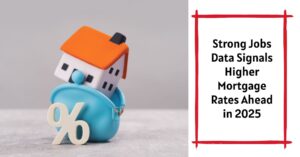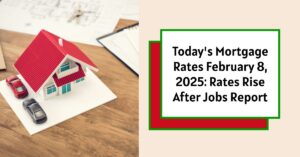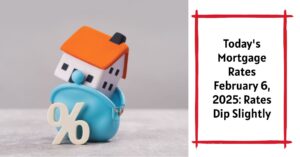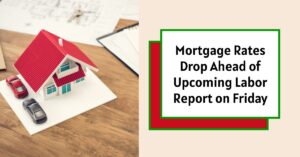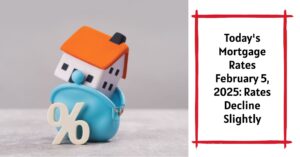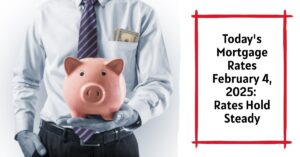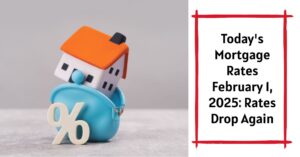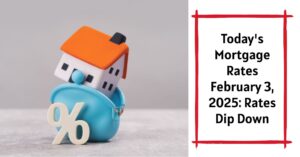Are you dreaming of buying a home and eagerly awaiting lower mortgage rates? Well, the latest January jobs report might have thrown a bit of a wrench into those plans. While the report isn't all bad news, it suggests that the Federal Reserve is less likely to cut interest rates soon, which means mortgage rates are likely to remain elevated in the near term.
Mortgage Rates Expected to Rise Further Due to Strong Jobs Data
A Mixed Bag of Economic Signals
Every month, the Bureau of Labor Statistics (BLS) releases the jobs report, and it's a big deal because it gives us a snapshot of the health of the U.S. economy. This report influences everything from stock prices to what the Fed decides to do with interest rates. And interest rates, as you know, directly affect mortgage rates.
The January report showed that the U.S. economy added 143,000 nonfarm payroll jobs. Now, that sounds like a decent number, and it is a sign of continued growth. However, it was slightly below what economists were expecting. Some experts believe that the slower growth could be attributed to winter storms in the East and South, as well as the wildfires in Los Angeles. It's hard to say for sure, but weather events definitely can throw a curveball into economic data.
What the Experts Are Saying
I've been following this stuff for a while now, and one thing I've learned is that no single piece of data tells the whole story. You have to look at the bigger picture and listen to what the experts are saying.
Mike Fratantoni, the Senior Vice President and Chief Economist at the Mortgage Bankers Association (MBA), put it pretty well. He said that the job market remains “reasonably strong,” noting that job growth over the past three months has averaged a gain of 237,000, which is likely above what can be sustained for the whole year.
Lisa Sturtevant, the chief economist at Bright MLS, highlighted the “mixed bag” aspect of the report. She pointed out that while more jobs are being added in relatively high-wage sectors, which boosts homebuyers' confidence, the healthy pace of job growth combined with inflation above the Fed’s 2% target means the central bank is likely to keep interest rates unchanged in March. This could lead to mortgage rates remaining in the high 6% range heading into spring.
Unemployment Numbers: A Closer Look
While job growth was a bit softer than expected, the unemployment rate actually fell slightly to 4.0%, with 6.8 million people unemployed. This is definitely a positive sign. A low unemployment rate generally indicates a strong labor market, which can fuel consumer spending and economic growth.
Sector-Specific Job Growth: Who's Hiring?
The January jobs report also breaks down job growth by industry sector. This can give us insights into which parts of the economy are doing well and which are struggling.
Here’s a breakdown of the key sectors:
- Health Care: Added 44,000 jobs. This sector has been a consistent source of job growth for a while now, driven by an aging population and increasing demand for healthcare services.
- Retail Trade: Added 34,000 jobs. This is an interesting one, as retail has been facing challenges from online shopping. However, it seems like brick-and-mortar stores are still holding their own, especially as the holiday shopping season extends its influence.
- Social Assistance: Added 22,000 jobs. This sector provides services like childcare, elderly care, and support for people with disabilities. The demand for these services is growing, leading to job creation.
- Mining, Quarrying, and Oil and Gas Extraction: Lost 8,000 jobs. This sector is highly sensitive to changes in energy prices and government regulations. The job losses could be related to lower oil prices or increased environmental regulations.
- Construction: Added 4,000 jobs, with residential construction adding 1,900 jobs. However, the number of residential specialty trade contractors fell by 2,100. This suggests that while overall construction is growing, there might be some challenges in the residential sector, possibly due to labor shortages or rising material costs.
- Real Estate: Rose by 3,600 jobs. The real estate industry has been facing headwinds due to higher interest rates and affordability challenges. But, it is showing signs of resilience and moderate recovery.
The Fed's Dilemma: Inflation vs. Economic Growth
The Federal Reserve has a tough job. They have to balance two competing goals: keeping inflation under control and promoting economic growth. Right now, inflation is still above the Fed's 2% target. The latest CPI (Consumer Price Index) data showed that inflation is proving to be stickier than initially anticipated.
If the Fed cuts interest rates too soon, it could risk reigniting inflation. But if they keep rates too high for too long, it could slow down economic growth and even lead to a recession. It’s a tightrope walk.
What Does This Mean for Mortgage Rates?
So, how does all of this translate to mortgage rates? As I said at the beginning, the January jobs report dampens hope for lower mortgage rates, at least in the short term. With the economy still showing signs of strength, the Fed is likely to remain cautious about cutting interest rates.
Fratantoni and the MBA are anticipating that the Fed will make, at most, one more rate cut this cycle. This suggests that mortgage rates are likely to remain elevated for the foreseeable future, probably hovering in the high 6% range.
Is There Any Hope for Lower Rates?
Don't despair just yet! There are still a few things that could lead to lower mortgage rates down the road.
- A Slowdown in Economic Growth: If the economy starts to weaken significantly, the Fed might be forced to cut interest rates to stimulate growth.
- A Sharp Drop in Inflation: If inflation starts to fall rapidly and consistently, the Fed would have more room to cut rates without risking a resurgence of inflation.
- Geopolitical Events: Unexpected events like a major global recession or a significant drop in oil prices could also lead to lower interest rates.
Recommended Read:
Mortgage Rates Trends on February 8, 2025
Will Trump Lower Mortgage Interest Rates in 2025?
What Should Homebuyers Do?
If you're planning to buy a home in the near future, here are a few things to keep in mind:
- Get Pre-Approved: Getting pre-approved for a mortgage will give you a better idea of how much you can afford and will make you a more attractive buyer to sellers.
- Shop Around for the Best Rates: Don't just go with the first lender you find. Compare rates and fees from multiple lenders to make sure you're getting the best deal.
- Consider an Adjustable-Rate Mortgage (ARM): If you're comfortable with the risk, an ARM might offer a lower initial interest rate than a fixed-rate mortgage. However, be aware that the rate could increase in the future.
- Be Patient: If you're not in a hurry to buy, you might want to wait and see if mortgage rates come down later in the year.
- Focus on Affordability: Don't stretch yourself too thin to buy a home. Make sure you can comfortably afford the monthly payments, property taxes, and insurance.
The Bottom Line
The January jobs report dampens hope for lower mortgage rates in the short term. The economy is still relatively strong, which means the Fed is likely to remain cautious about cutting interest rates. Mortgage rates are likely to remain elevated for the foreseeable future.
If you're planning to buy a home, be prepared for higher rates. Shop around for the best deal, focus on affordability, and be patient. Remember, buying a home is a long-term investment, so don't let short-term fluctuations in interest rates deter you from pursuing your dreams.
Table: Key Takeaways from January Jobs Report
| Metric | January Data | Significance |
|---|---|---|
| Nonfarm Payroll Jobs Added | 143,000 | Slightly below expectations; indicates continued job growth but may not prompt Fed rate cuts soon |
| Unemployment Rate | 4.0% | Low unemployment supports a strong labor market; reduces pressure on the Fed to cut rates |
| Key Sectors Growth | Health Care, Retail Trade, and Social Assistance added jobs; Mining, Quarrying, and Oil and Gas Extraction lost jobs | |
| Mortgage Rates Outlook | High 6% range | Expected to remain elevated due to strong job market and inflation above Fed's target; limited possibility of substantial rate cuts in the near term |
I know it's frustrating when you're hoping for something like lower mortgage rates and the data doesn't cooperate. But remember, the market is always changing, and it's important to stay informed and make the best decisions you can with the information you have.
Work with Norada in 2025, Your Trusted Source for
Real Estate Investing
With mortgage rates fluctuating, investing in turnkey real estate
can help you secure consistent returns.
Expand your portfolio confidently, even in a shifting interest rate environment.
Speak with our expert investment counselors (No Obligation):
(800) 611-3060
Recommended Read:
- Mortgage Rates Forecast for the Next 3 Years: 2025 to 2027
- 30-Year Mortgage Rate Forecast for the Next 5 Years
- 15-Year Mortgage Rate Forecast for the Next 5 Years
- Why Are Mortgage Rates Going Up in 2025: Will Rates Drop?
- Why Are Mortgage Rates So High and Predictions for 2025
- NAR Predicts 6% Mortgage Rates in 2025 Will Boost Housing Market
- Mortgage Rates Predictions for 2025: Expert Forecast
- Will Mortgage Rates Ever Be 3% Again: Future Outlook
- Mortgage Rates Predictions for Next 2 Years
- Mortgage Rate Predictions for Next 5 Years
- Mortgage Rate Predictions for 2025: Expert Forecast
- Mortgage Rate Predictions: Why 2% and 3% Rates are Out of Reach
- How Lower Mortgage Rates Can Save You Thousands?
- How to Get a Low Mortgage Interest Rate?
- Will Mortgage Rates Ever Be 4% Again?
